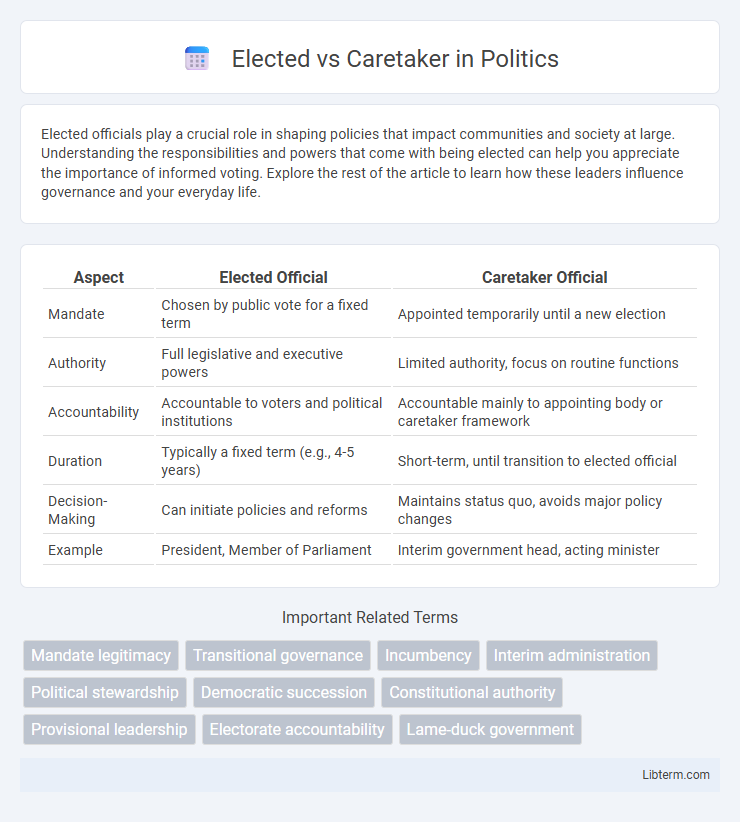Elected officials play a crucial role in shaping policies that impact communities and society at large. Understanding the responsibilities and powers that come with being elected can help you appreciate the importance of informed voting. Explore the rest of the article to learn how these leaders influence governance and your everyday life.
Table of Comparison
| Aspect | Elected Official | Caretaker Official |
|---|---|---|
| Mandate | Chosen by public vote for a fixed term | Appointed temporarily until a new election |
| Authority | Full legislative and executive powers | Limited authority, focus on routine functions |
| Accountability | Accountable to voters and political institutions | Accountable mainly to appointing body or caretaker framework |
| Duration | Typically a fixed term (e.g., 4-5 years) | Short-term, until transition to elected official |
| Decision-Making | Can initiate policies and reforms | Maintains status quo, avoids major policy changes |
| Example | President, Member of Parliament | Interim government head, acting minister |
Introduction to Elected and Caretaker Positions
Elected positions are roles filled through a formal voting process where candidates compete to represent a constituency, often involving campaigns and public mandates. Caretaker positions are temporary roles assigned to maintain operations and ensure stability during transitions, typically without the power to make long-term policy changes. Understanding the distinction helps clarify authority levels and responsibilities in governance and organizational structures.
Defining Elected Officials
Elected officials hold public office as a result of winning an election, embodying the democratic will of the voters through a formal electoral process. Their authority derives from the mandate given by constituents, granting them decision-making power on policies, budgets, and governance. Unlike caretakers who manage responsibilities temporarily without electoral legitimacy, elected officials serve fixed terms defined by law and are accountable to the electorate.
What is a Caretaker Government?
A caretaker government is a temporary administration appointed to manage routine functions and maintain government operations during a transitional period, typically following the dissolution of parliament or before a newly elected government takes office. It ensures continuity of governance without implementing major policy changes or long-term commitments, preserving neutrality and stability. This type of government is essential in democratic systems to avoid power vacuums and uphold constitutional processes during election cycles.
Core Differences Between Elected and Caretaker Roles
Elected officials hold office through a formal voting process, possessing a defined mandate, policy-making authority, and accountability to the electorate. Caretaker roles are temporary, focusing on maintaining daily operations without implementing significant policy changes or long-term decisions. The core difference lies in the legitimacy derived from electoral endorsement versus the interim custodial function aimed at preserving stability.
Legal Framework Governing Both Positions
The legal framework governing elected officials is defined by constitutional statutes, electoral laws, and specific mandates outlining their responsibilities and tenure. Caretaker officials operate under temporary regulations and emergency provisions that restrict their authority primarily to routine administration, avoiding major policy decisions. This distinction ensures that elected representatives have full legislative power while caretakers maintain continuity of governance during transitional periods.
Powers and Limitations: Elected vs Caretaker
Elected officials possess full governing powers, enabling them to implement policies, approve budgets, and make binding decisions that reflect the electorate's mandate. Caretaker governments operate under strict limitations, primarily maintaining routine administration without initiating major policy changes or appointments. The fundamental distinction lies in the elected authority's legal legitimacy to enact long-term plans, while caretaker administrations are confined to preserving stability until a new government is formed.
Accountability and Public Trust
Elected officials hold direct accountability to voters through regular elections, which reinforces public trust by ensuring their decisions reflect constituents' interests and priorities. Caretaker administrations operate temporarily without an electoral mandate, limiting their accountability primarily to legal frameworks or appointing authorities, often causing reduced public confidence. The sustained legitimacy of elected leaders fosters stronger community engagement and transparency, critical for effective governance and societal stability.
Impact on Policy and Decision-Making
Elected officials hold a mandate from voters, enabling them to implement long-term policies aligned with their campaign promises and public priorities, significantly shaping legislative agendas. Caretaker governments, limited by their interim status, focus on maintaining stability and continuity, often avoiding major policy changes or controversial decisions to preserve neutrality. This distinction directly impacts policy innovation, with elected leaders driving reform while caretakers emphasize administrative maintenance.
Transition of Authority: Procedures and Challenges
Transition of authority from elected to caretaker governments requires strict adherence to legal frameworks and constitutional mandates to ensure legitimacy and continuity. Key procedures include formal handover of power, maintaining administrative neutrality, and safeguarding ongoing policy implementation without bias towards political interests. Challenges often arise from ambiguity in timelines, resistance from outgoing parties, and potential disruptions in governance that can impact public trust and institutional stability.
Conclusion: Choosing Between Elected and Caretaker Models
Choosing between elected and caretaker governance models depends on stability, legitimacy, and administrative efficiency. Elected models offer democratic legitimacy through public mandate, while caretaker systems provide transitional stability during political uncertainty. Prioritizing long-term governance goals alongside immediate administrative needs ensures an optimal selection tailored to specific political contexts.
Elected Infographic

 libterm.com
libterm.com